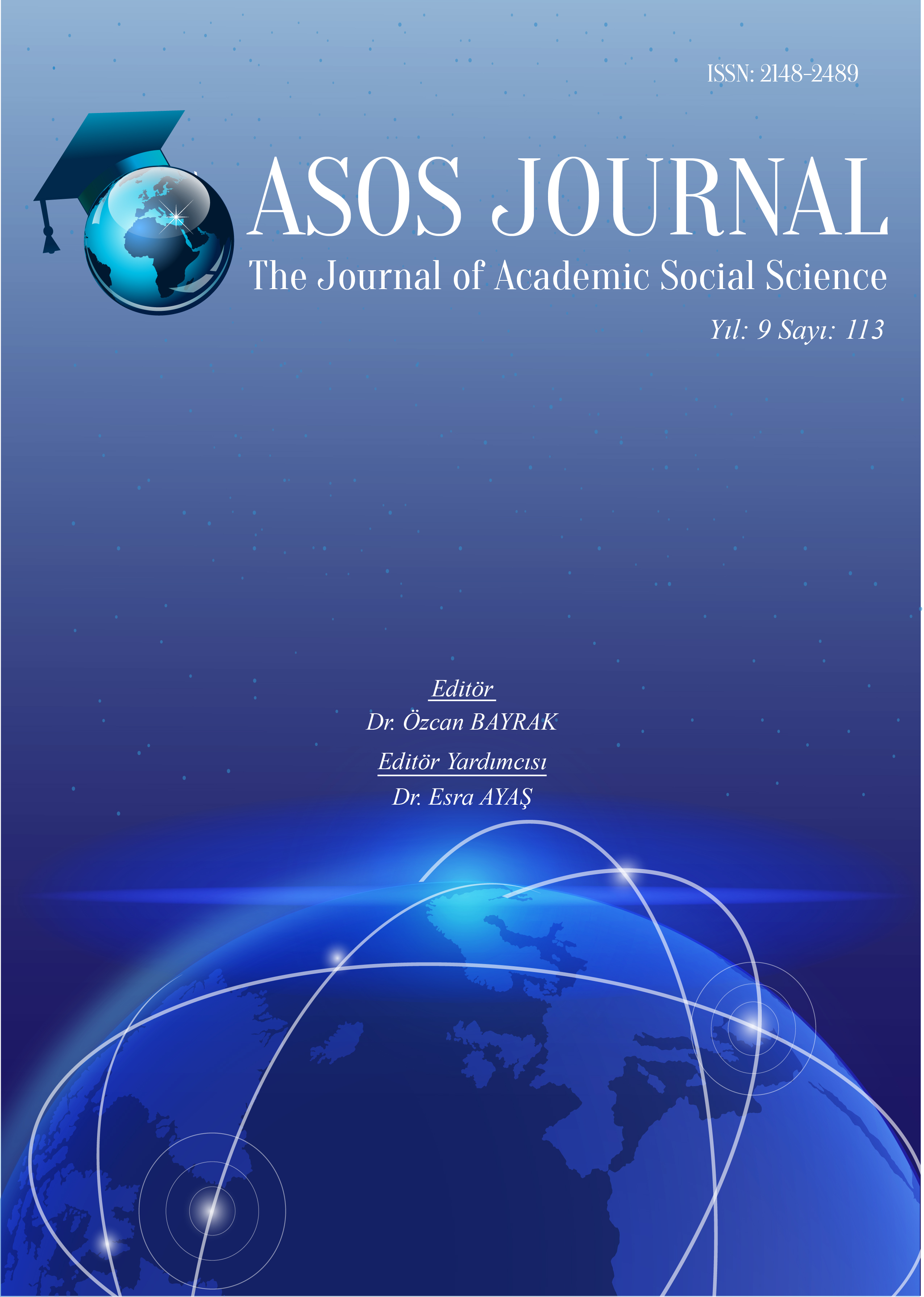Author :
Abstract
Bu çalışmada, 8. sınıflar için bir konuşma dersi geliştirmek için öğrencilerin gerçek eğitim ihtiyaçlarını anlamak amacıyla ihtiyaç değerlendirme çalışması yapılmıştır. Üç farklı veri toplama yöntemi kullanılmıştır. Bunlardan biri konuşma dersi ile ilgili soruların olduğu bir öğrenci anketidir, ikincisi öğrenciler için bir tutum ölçeği ve sonuncusu ise öğretmenler için yarı yapılandırılmış bir görüşme formudur. Öğrencilerin ihtiyaçları ve tercihleri toplanan verilere göre raporlandı ve tartışıldı. Elde edilen sonuçlara bakıldığında, öğretmenlerin öğrencilerin İngilizceye karşı olumsuz tutumları olduğunu belirtmelerine rağmen öğrencilerin İngilizceye karşı olumlu tutumları olduğu ortaya çıkmıştır. İletişimsel konuşma etkinlikleri öğrenciler tarafından tercih edilmesine rağmen öğretmenler tarafından uygulanmadığı görüldüğü için gerekli önerilerde bulunulmuştur.
Keywords
Abstract
To design a speaking course curriculum for 8th graders, a needs assessment study was conducted in order to accomplish designing a communicative speaking course through understanding the real educational needs of the students. Three data collection methods were utilized. One of them was a student survey which had questions about a speaking course, second one was an attitude scale for students and the last was a semi-structure interview for the teachers. Needs and preferences of the students were reported and discussed accordingly. Considering the results, although teachers stated that students have negative attitudes towards English it was found out that the students have positive attitudes towards English. As communicative speaking activities were preferred by the students but not applied by teachers, necessary suggestions were made.
Keywords
- Agbatogun, A. O. (2014). Developing learners’ second language communicative competence through active learning: Clickers or communicative approach? Educational Technology and Society, 17(2), 257–269.
- Anbarlı-Kırkız, Y. (2010). Öğrencilerin İngilizce dersine ait tutumları ile akademik başarıları arasındaki ilişki. Unpublished Master Thesis, Trakya University.
- Bashir, M., Azeem, M., & Dogar, A. H. (2011). Factor effecting students’ English speaking skills. British Journal of Arts and Social Sciences, 2(1), 34–50.
- Boonkit, K. (2010). Enhancing the development of speaking skills for non-native speakers of English. Procedia - Social and Behavioral Sciences, 2(2), 1305–1309.
- Chan, M. (2009). What learning contracts reveal about university students’ attitude towards English language learning. The International Journal of Learning, 16(9), 19–31.
- Davies, P. (1990). The Use of Drama in English Language Teaching. TESL Canada Journal, 8(1), 87–99.
- Dönmez-Günal, O. D., & Engin-Demir, C. (2012). Implementation of the New Eighth Grade English Language Curriculum from the Perspectives of Teachers and Students. Procedia-Social and Behavioral Sciences, 47, 1002-1006.
- Emerson, T. L. N., & Taylor, B. A. (2004). Comparing student achievement across experimental and lecture-orientated sections of a principle of microeconomics course. Southern Economics Journal, 70, 672-693.
- Eslami-Rasekh, Z., & Valizadeh, K. (2004). Classroom activities viewed from different perspectives: Learners’ voice vs. teachers’ voice. TESL-EJ, 8(3), 1-13.
- Fenwick, W., & Kaufman, R. A. (1975). Needs Assessment: A Focus for Curriculum Development.
- Gardner, R. C. (1985). Social psychology and second language learning. London: Edward Arnold.
- Guntermann, G. (1987). Designing Programs for Foreign Languages. Theory into Practice, 26(4), 276-281.
- Hawkey, R. (2006). Teacher and learner perceptions of language learning activity. ELT Journal, 60(3), 242–252. doi:10.1093/elt/ccl004
- Iwaniec, J. (2020). The effects of parental education level and school location on language learning motivation. The Language Learning Journal, 48(4), 427-441.
- Karahan, F. (2007). Language attitudes of Turkish students towards the English language and its use in Turkish context. Journal of Arts and Sciences, 7, 73–87.
- Kırkgöz, Y. (2007). English Language Teaching in Turkey: Policy Changes and their Implementations. RELC Journal, 38(2), 216–228.
- Küçük, A. N. (2011). The Application of Communicative Language Teaching (CLT) in Turkish Primary and Secondary Schools. Retrieved from www.hltmag.co.uk/dec11/sart05.rtf .
- MacIntyre, P. D. (2007). Willingness to communicate in the second language: Understanding the decision to speak as a volitional process. The Modern Language Journal, 91(4), 564576.
- McDonough, S. M. (1995). Strategy and skill in learning a foreign language. London: Edward
- Mulling, S. S. (1997). Getting Them to Talk: Communicative Activities for the ESOL Classroom.
- Murad, T. M. (2009). The Effect of Task-Based Language Teaching on Developing Speaking Skills among the Palestinian Secondary EFL Students in Israel and Their Attitudes towards English. Unpublished Master Thesis, Yarmouk University.
- Nikolov, M. (Ed.). ( 2009). The age factor and early language learning. Berlin-New York: Mouton de Gruyter.
- Nuktong, P. (2010). The Effects of Drama Based Instruction on English Oral Communication Ability and Motivation in Learning English of Eleventh Grade Students. Unpublished Master Thesis, Chulalongkorn University.
- Qinghong, M. (2009). Key elements in conducting communicative approach to language teaching. Canadian Social Science, 5(2), 46–55.
- Richards, J. C. (2005). Communicative language teaching today. SEAMEO Regional Language Centre.
- Saeed, K. M., Khaksari, M., Eng, L. S., & Ghani, A. M. A. (2016). The Role of Learner Learner Interaction in the Development of Speaking Skills. Theory and Practice in Language Studies, 6(2), 235.
- Samperio Sanchez, N. (2017). Discovering Students' Preference for Classroom Activities and Teachers' Frequency of Activity Use. Colombian Applied Linguistics Journal, 19(1), 51-66.
- Smith, F., Hardman F., & Higgins S. (2006). The impact of interactive whiteboards on teacher– student interaction in the national literacy and numeracy strategies. British Educational Research Journal, 32, 437–451.
- Strakšienė, G. (2015). Explication of Activities in the Textbooks on Developing Primary School Age Children’s Communicative Competence, Pedagogy, 119(3), 82–96.
- Tang, E. K. (1990). Developing speaking skills with games : towards a co-operative learning approach. Proceedings of The 16th Conference of Pan-Pacific Association of Applied Linguistics.
- Thiyagarajan, K., & Phil, M. (2014). Integrating Short Stories in the ESL Classroom for Developing Learners’ Communicative Competence. Language in India, 14(12).
- Tuan, L. T., & Nhu, N. T. K. (2010). Theoretical review on oral interaction in EFL classrooms. Studies in Literature and Language,1(4), 29-48.
- Tsou, W. (2005). Improving speaking skills through instruction in oral classroom participation. Foreign Language Annals, 38(1), 46-55.
- İlköğretim Kurumları İngilizce Dersi Öğretim Programı, 2013- http://ttkb.meb.gov.tr/www/guncellenen-ogretim-programlari/icerik/151
